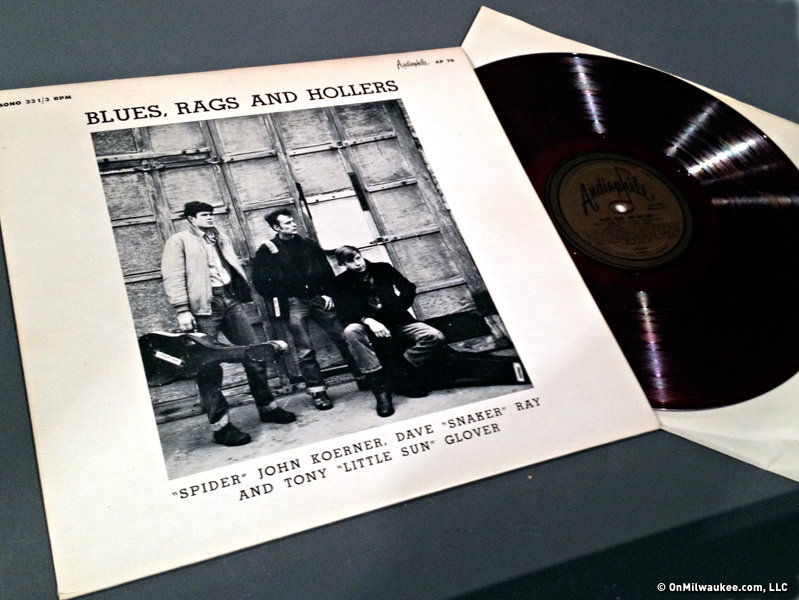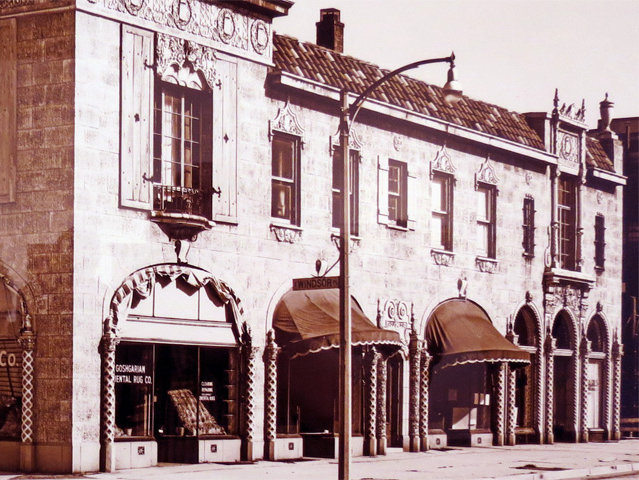As part of "The Avant Garde Coffee House Project" exhibit currently on view, there’s a glass-topped case with some posters and a record. It’s a pretty nondescript thing, frankly, with a black and white photo and some not especially artful text.
But that little record – "Blues, Rags and Hollers," by folk blues trio Koerner, Ray & Glover – made a big bang when it was released in June 1963.
The disc, by a trio of young white musicians from Minneapolis, was a landmark record in the folk revival that was in full blossom by then. Released by Saukville-based Audiophile Records, "Blues, Rags and Hollers" earned Spider John Koerner, Dave Snaker Ray and Tony "Little Sun" Glover a contract with Elektra Records.
According to Glover’s 1986 documentary on the trio – also called "Blues, Rags & Hollers":
"In March 1963, it was still front page news when blacks were admitted to Southern colleges without violent incidents. It was nearly a year before the Beatles made their first visit to the U.S. On a spring weekend three young men drove all night through heavy fog, from Minneapolis to Milwaukee. On a Sunday, in an all-day session, Koerner, Ray & Glover recorded 'Blues, Rags and Hollers,' an album that became the cornerstone in the 1960s folk and blues revival."
That session, with label boss Ewing Nunn (heir to the Nunn Bush shoes empire), took place at the Women’s Club, 813 E. Kilbourn Ave., on March 24, 1963.
"Man, that first record was something else," recalled Ray, who died in 2002, in the film. "Tony knew Paul Nelson who got that together through the Little Sandy Review (a folk music fanzine). If I remember correctly we got this guy interested – Nunn of Nunn Bush shoes.
"This Ed Nunn was a crazy son of a gun, man. He made his own microphones and he had this old Magnacord tape recorder – two-track tape recorder. He hot-wired that sucker.
Koerner picked up the story: "We got to Milwaukee and it was a very strange situation. It was very straight-laced. We weren’t allowed to swear and we weren’t allowed to drink. It was sort of a cold place."
"We went and we did that session and, hell, we did 15 or 20 tunes in about 12 hours flat in this women’s civic club overlooking Lake Michigan," said Ray.
"I don’t think (Nunn) had ever seen anything quite like us. He didn’t really know what to make of three young white boys doing blues. I don’t think he’d heard any blues before, to tell you the truth. But he did us all right and we were able to parlay the tape into a contract with (Elektra founder Jac) Holzman by sending him out the record we had done."
When the LP was issued in June, it had 20 tracks crammed onto one LP – an audio overload that led the 300 red vinly copies in the first pressing – manufactured by Wakefield in Phoenix – to suffer from excessive noise.
But that hiss, crackle and pop didn’t diminish the power of the music captured in the tightly-fitted grooves. All Music has called it "one of the defining albums of the folk revival" and another critic reviewing a 2004 reissue said "Blues, Rags and Hollers" "got it exactly right ... still sounds pretty fresh all these years later."
Still, when Elektra released the disc nationally in November, it provided some breathing room by cutting four tracks.
After signing with Elektra, the label flew the trio to New York to record, "Lots More Blues, Rags and Hollers," which was released in June 1964.
The tunes on the record were a mix of traditional tunes, original songs written by each of the three members and covers of blues tunes penned by Lightnin’ Hopkins, Elmore James, Blind Lemon Jefferson, Leadbelly, Sleepy John Estes, Cat Iron and Peg Leg Howell.
The trio performed at the Newport Folk Festival in ‘64 and continued on together into the ‘70s. They reunited occasionally until Ray’s death in 2002 and Koerner and Glover are still active up in the Twin Cities.
Nunn, who had begun recording in 1947, continued on, releasing almost 100 records by the mid-70s, when the label was bought out by The George H. Buck, Jr., Jazz Foundation and moved to New Orleans. Nunn died in 1977.
In a biography of Jim Morrison, respected music writer Stephen Davis said that signing Koerner, Ray & Glover "gave Elektra considerable street cred," and that "Blues, Rags and Hollers" was "the coolest, hardest-rocking record of the whole folk revival."
Born in Brooklyn, N.Y., where he lived until he was 17, Bobby received his BA-Mass Communications from UWM in 1989 and has lived in Walker's Point, Bay View, Enderis Park, South Milwaukee and on the East Side.
He has published three non-fiction books in Italy – including one about an event in Milwaukee history, which was published in the U.S. in autumn 2010. Four more books, all about Milwaukee, have been published by The History Press.
With his most recent band, The Yell Leaders, Bobby released four LPs and had a songs featured in episodes of TV's "Party of Five" and "Dawson's Creek," and films in Japan, South America and the U.S. The Yell Leaders were named the best unsigned band in their region by VH-1 as part of its Rock Across America 1998 Tour. Most recently, the band contributed tracks to a UK vinyl/CD tribute to the Redskins and collaborated on a track with Italian novelist Enrico Remmert.
He's produced three installments of the "OMCD" series of local music compilations for OnMilwaukee.com and in 2007 produced a CD of Italian music and poetry.
In 2005, he was awarded the City of Asti's (Italy) Journalism Prize for his work focusing on that area. He has also won awards from the Milwaukee Press Club.
He has be heard on 88Nine Radio Milwaukee talking about his "Urban Spelunking" series of stories, in that station's most popular podcast.






